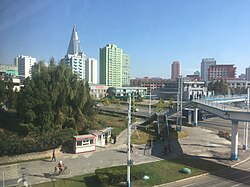Potonggang-guyok | |
|---|---|
Guyŏk of Pyongyang | |
| Korean transcription(s) | |
| • Hangul | 보통강구역 |
| • Hanja | 普通 江 區 域 |
| • Revised Romanization | Botonggang-guyeok |
| • McCune–Reischauer | Pot'onggang-guyŏk |
 | |
 Location of Potonggang-guyok within Pyongyang | |
| Country | North Korea |
| Direct-administered city | P'yŏngyang-Chikhalsi |
| Administrative divisions | 15 administrative dong |
| Area | |
• Total | 7.3 km2 (2.8 sq mi) |
| Population (2008) [1] | |
• Total | 105,180 |
| • Density | 14,000/km2 (37,000/sq mi) |
Potonggang-guyok is one of the 18 districts, or guyok, of Pyongyang, North Korea. It is best known as the location of the Ryugyong Hotel. It takes its name from the Pothong River (literally "the simple river"), which forms the district's boundary. Potonggang is bordered to the north by Hyongjesan-guyok, to the east by Sosong and Moranbong, to the south by Pyongchon and Chung, and to the west by Mangyongdae-guyok. The district was established by the Pyongyang City People's Committee in October 1960.